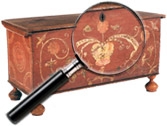Hilla Anna Rebay (American, 1890 to 1967)
Grace Glueck wrote “She was an accomplished painter, a friend of great artists and a woman of strong, sometimes dogmatic views who more or less invented the Museum of Non-Objective Painting, the early version of the Solomon R. Guggenheim Museum.
Yet today the German-born Hilla von Rebay is little recognized, except to art worldlings with very long memories. When she is recalled, it is as the art adviser to Solomon Guggenheim, the wealthy collector who backed the Museum of Non-Objective Painting, and as the first director and curator of the fledgling institution. Her role as an artist has always been played down. But now the Guggenheim itself, which has long kept Rebay’s archives and her extensive body of art in storage, has stepped into the breach. With the Museum Villa Stuck of Munich and Schlossmuseum Murnau, it has organized a full-dress show of some 140 examples of Rebay’s own work over six decades.
For context, the exhibition includes works by some of her colleagues and friends, among them Arp, Kandinsky, Hans Richter and Kurt Schwitters. Paintings by Leger, Gris, Picasso, John Ferren, Ben Nicholson, Jean Xceron and others are also included.
In her day, there was significant hostility toward Rebay (pronounced reh-BYE). She was a complicated, dynamic woman, take-charge and bossy, who aroused jealousy in the art world by her closeness (though it was probably not romantic) to Guggenheim.
It was also said, while she was running the museum, that she gave excessive exhibition space to the work of her longtime lover, the less than stellar German painter Rudolf Bauer. And her deeply held, mystical theosophist views, which she shared with Kandinsky and others – about the importance of intuition and the artist’s role as interpreter for an otherworldly power – exposed her to ridicule in some art quarters.
She probably met Irene and Solomon Guggenheim through a banker friend, and after Irene’s purchase of two paintings from the gallery show Rebay was commissioned to do a portrait of Guggenheim. During the sittings, she revealed her passion for nonobjective painting and urged Guggenheim to collect it. She particularly pushed the work of Bauer. Encouraged by Guggenheim’s response, Rebay, on a return trip to Paris for a show of her work, sought advice from the painter Albert Gleizes about developing a collection of nonobjective art for the couple. And on a subsequent visit to Berlin she had Bauer buy paintings, based on her predilections, for Guggenheim’s budding collection.
To cut a long story short, Solomon Guggenheim was willing, buying up art by Kandinsky, Delaunay, Leger, Chagall, Nicholson, Barbara Hepworth and, of course, Bauer (of which he acquired far too many examples). On June 1, 1939, the Museum of Non-Objective Painting opened, in a former automobile showroom at 24 East 54th Street, with Rebay as its curator. The inaugural exhibition, titled “Art of Tomorrow” with a nod to the simultaneous New York World’s Fair, included 14 works by RebayDetermined to find a more distinguished and permanent home for the museum, Rebay – perhaps at the prompting of Irene Guggenheim – turned in 1943 to the idealistic Frank Lloyd Wright for a “temple” or “monument” to the spirit of art. Its completion took some 15 years, but eventually Wright, who formed a strong friendship with Rebay, was able to credit her (as Joan M. Lukach wrote in a 1983 biography of Rebay) as the only woman to put a museum on Fifth Avenue. (The new building would not have been possible, of course, without the funds and dedicated support of Guggenheim, who died 10 years before it opened.)”1
1. New York Times, May 20, 2005, by Grace Glueck, “Guiding Spirit of the Guggenheim Was an Artist in Her Own Right”.
Information courtesy of Shannon’s Fine Art Auctioneers, April 2010.
